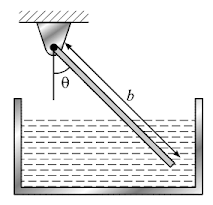Question
Medium
Solving time: 3 mins
A uniform rod of length capable of tuning about its end which is out of water, rests inclined to the vertical. If its specific gravity is , find the length immersed in water.

 Text solution
Text solution Verified
Verified
Was this solution helpful?
151
Share
Report
Found 5 tutors discussing this question
Discuss this question LIVE
5 mins ago

One destination to cover all your homework and assignment needs
Learn Practice Revision Succeed

Instant 1:1 help, 24x7
60, 000+ Expert tutors

Textbook solutions
Big idea maths, McGraw-Hill Education etc

Essay review
Get expert feedback on your essay

Schedule classes
High dosage tutoring from Dedicated 3 experts
Practice questions from Physics Galaxy Mechanics Vol 1 (Ashish Arora)
Question 1
Hard
Views: 6,153
Question 2
Medium
Views: 5,348
Question 3
Medium
Views: 5,442
Question 4
Medium
Views: 5,197
Practice more questions from Mechanical Properties of Fluids
Question 1
Medium
Views: 5,683
Question 2
Easy
Views: 5,135
Question 3
Easy
Views: 5,547
Question 4
Easy
Views: 5,935
Practice questions on similar concepts asked by Filo students
Question 1
Views: 5,974
Question 2
Views: 5,443
Question 3
Views: 5,041
Question 4
Views: 6,029


Stuck on the question or explanation?
Connect with our Physics tutors online and get step by step solution of this question.
231 students are taking LIVE classes
| Question Text | A uniform rod of length capable of tuning about its end which is out of water, rests inclined to the vertical. If its specific gravity is , find the length immersed in water. |
| Topic | Mechanical Properties of Fluids |
| Subject | Physics |
| Class | Class 11 |
| Answer Type | Text solution:1 |
| Upvotes | 151 |
